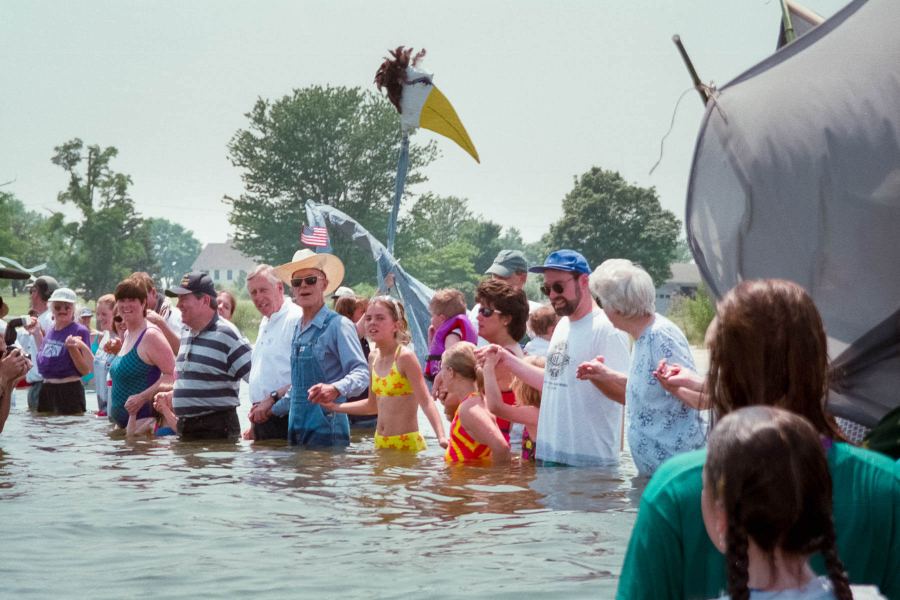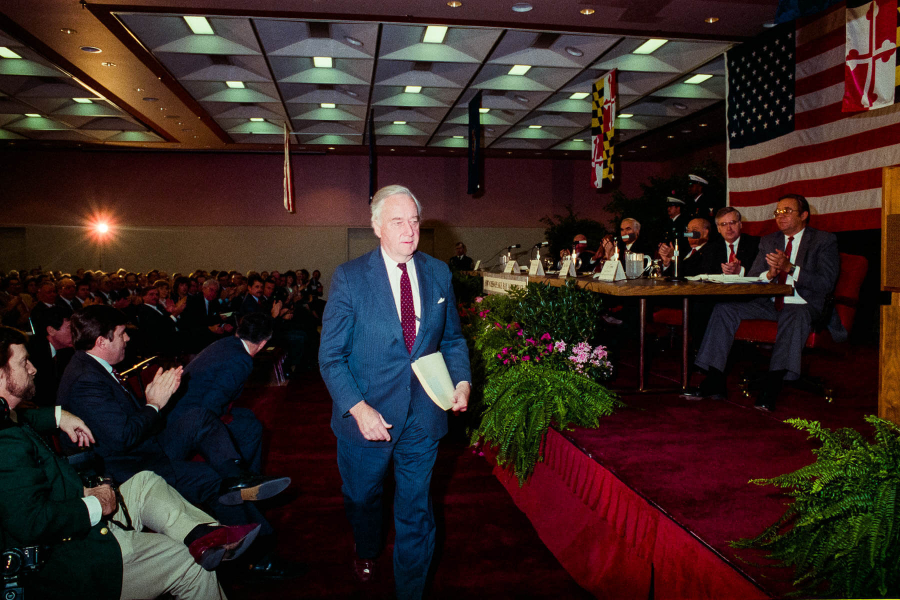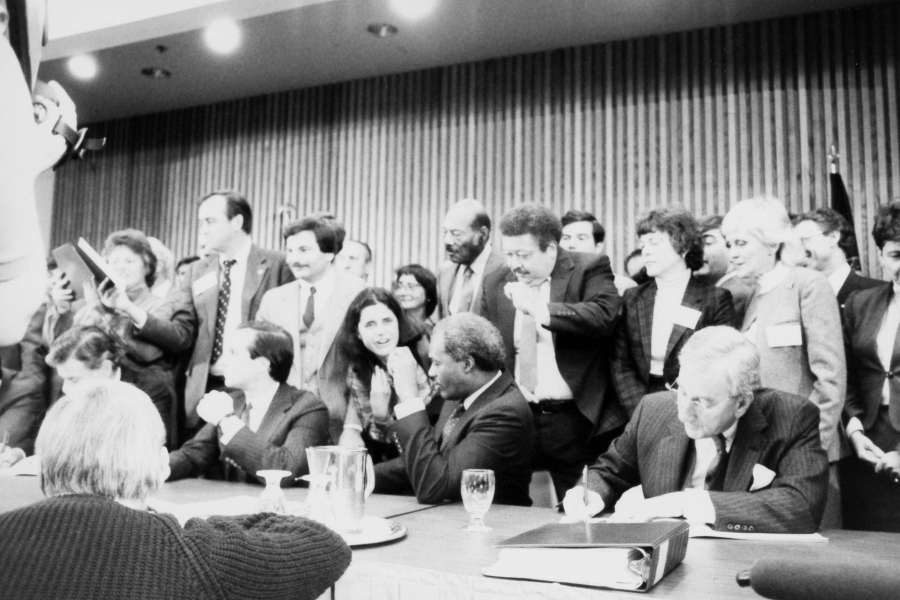Celebrating 40 years of science, restoration and partnership
The Chesapeake Bay Program turns 40 in 2023

True to form for the Chesapeake Bay Program, our partnership was formed in response to a rigorous scientific study.
The year was 1975, and the Bay was in rough shape. A U.S. Senator and Maryland-native named Charles "Mac" Mathias took it upon himself to publicize the decline of the ecosystem through various listening tours, boat trips and media coverage. He showed murky water and fish kills, discussed the loss of species such as ducks and oysters, and gave a voice to those who worked on, lived by and studied the Bay.
Eventually, Mathias was able to persuade the Senate Appropriations Committee to fund an investigation of the Bay’s health. Though it was clear that the health of the Bay was in decline, an investigation was needed to understand the extent of the problem and examine why past restoration efforts had failed.
Over seven years, the Environmental Protection Agency (EPA), along with a number of nonprofit and academic partners, conducted a series of studies culminating in the first basin-wide assessment of the Chesapeake Bay, its tributaries and the surrounding land. The studies identified several factors leading to the estuary’s poor health, including shoreline erosion, the accumulation of toxic substances, industrial dredging, the decline of submerged aquatic vegetation (SAV) and nutrient runoff. All these issues were found to impact one another, which meant they would have to be addressed equally for progress to be made.
"If the Chesapeake Bay is to survive, it must be addressed as an entity, as a total system without duplication and without omission." Senator Mac Mathias
Based on this technical understanding, the report then recommended a new approach to restoration. It was evident in the study that the watershed functions as a whole: actions in one part of the region effect rivers flowing into the Bay, which impacts wildlife like blue crabs and oysters. Therefore, it was recommended that a partnership should be formed between the federal government and the jurisdictions whose water flows into the Bay.
On December 7-9, 1983, two months after the study was released, over 700 people gathered in Fairfax, Virginia at a conference convened by the governors of Virginia, Maryland and Pennsylvania, the mayor of the District of Columbia, the EPA Administrator and the Chesapeake Bay Commission. The group signed a one-page document pledging to work together to restore the Bay. A few months later, Congress established the Chesapeake Bay Program under section 117 of the Clean Water Act—and the partnership was officially born.

40 years of restoration and partnership
For nearly 40 years, the Chesapeake Bay Program has coordinated this regional effort to restore the nation’s largest estuary.
Our accomplishments during this time have all come as a result of jurisdictions working together on solutions that impact the entire estuary. In the mid to late 1980’s, we implemented a ban on phosphorous detergent in Maryland, Virginia, the District of Columbia and Pennsylvania. In the late 1980’s and early 1990’s, we established regional harvest restrictions for striped bass that allowed the species to recover. From the 1990’s to early 2000’s, significant advancements in technology allowed us to accelerate our ongoing upgrades to waste-water treatment plants.
All along, and continuing to today, we have worked together to implement practices that drive down pollution loads, restore and conserve wetlands and forests, coordinate a sophisticated network to monitor the Bay’s health, and improve habitat conditions and coordinated fisheries management for both wild species and commercial fisheries, among other achievements.
Perhaps most importantly, the partnership has remained intact since forming, and in 2014, added the “headwater states” of New York, Delaware and West Virginia so that every jurisdiction in the watershed is represented.

As our 40th anniversary approaches, we are determined to overcome the Bay’s many challenges. The watershed looks very different than it did in 1983. Population growth has led to strained wastewater treatment plants, escalating urban runoff and a decrease in tree canopy. Agricultural production has intensified, causing more nutrients to flow into the Bay. And toxic contaminants increasingly enter the water as the use of plastic and hazardous materials grows.
In the past decade, we’ve also begun to see the impact of new challenges associated with climate change. More intense rainfall caused by a warming planet is in some cases worsening the habitat conditions for oysters and SAV, while sea level rise is flooding tidal wetlands and forests, making it more difficult to conserve them. These changes not only result in worsening water quality in the Bay, but cause disruptive flooding in communities throughout the watershed.
Celebrating our anniversary
In the face of mounting environmental challenges, the Chesapeake Bay Program will be celebrating its anniversary year by focusing on the 10 goals we set out to achieve in 2014, with the signing of the Chesapeake Bay Watershed Agreement.
Each month, we will focus on goals of the Watershed Agreement, telling stories that highlight the work of our partners, sharing our successes and explaining the challenges we face.
The goals in this Watershed Agreement represent the region’s most pressing environmental issues—from climate change to land conservation to wildlife protection. As realized in the study that launched the Chesapeake Bay Program, these issues are all inextricably linked, and require coordination across geographic, political and cultural borders to be solved.
This need is why the Chesapeake Bay Program partnership exists, and why we will continue to work towards a healthier Bay.

Comments
There are no comments.
Thank you!
Your comment has been received. Before it can be published, the comment will be reviewed by our team to ensure it adheres with our rules of engagement.
Back to recent stories